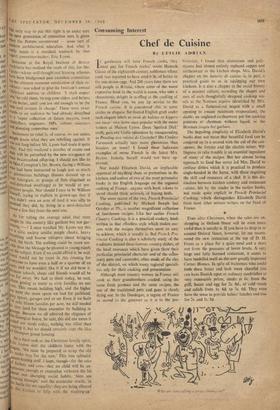Consuming Interest
Chef de Cuisine
By LESLIE ADRIAN 'Fgentlemen will have French cooks, they must pay for French tricks,' wrote Hannah Glasse of the eighteenth-century nobkman whose cook was reported to have used 6 lb. of butter to fry one dozen eggs. And 200 years later there are still people in Britain, where some of the worst expensive food in. the world is eaten; who take a chauvinistic delight in scoffing at the cooking of France. Mind you, we pay lip service to the French cuisine. It is considered chic in some circles to disguise flat-footed English grub under such elegant labels as steak de baleine or kippers SUP roa.vt—two items once popular with the menu writers at Maison Lyons. Does 'Spotted: Dick' really gain any Gallic splendour by masquerading as Fowling aux raisins de Corinthe? Do Crotites Yarmouth actually taste more glamorous than bloaters on toast? F found. these ludicrous examples of menu French in the latest Mrs. Beeton. Isabella herself would not have ap- proved.
Nor would Elizabeth David, an implacable opponent of anything sham or pretentious in the kitchen, and author of two of the most persuasive books in the English language on: the regional cooking of France: anyone with, book tokens to spend should think seriously of buying both.
The more recent of the two, French Provincial Cooking, published. by Michael Toseph last October at 35s., is another magnificent collection of farmhouse recipes. Like her earlier French Chuntry Cooking, it. is a practical cookery book written in that effortless style which makes suc- cess with. the recipes themselves seem so: easy to achieve; v‘hich it usually is. But French Pro- vincial Cooking is also a scholarly study: of the traditions behind these famous country dishes, of the local resources which have given them. their particular provincial character and' of the culto. mary pans and casseroles, often made of the clay of the district, on which many regional speciali- ties rely for their cooking and presentation; Although most country women in France still cook as their grandmothers cooked, using the same fresh produce and the same recipes, the use of the traditional: pots and: pans is slowly dying out'. In the Dordogne, a region of France as sacred to the gourmet as it is to the pre- historian, I found that aluminium and poly- styrene had almost entirely replaced copper and earthenware in the kitchen shops. Mrs. David's chapter on the batterie de cuisine is, in part, a practical guide to us in equipping our own kitchens. It Is also a chapter in the social history of a peasant culture, recording the shapes and uses of such thoughtfully designed cooking ves- sels as the Norman tripiere (described by Mrs. David as a flattened-out teapot with a small opening to ensure minimum evaporation), the (liable, an unglazed earthenware pot for cooking potatoes or chestnuts without liquid; or the B6arnais toupin for garbure.
The beguiling. simplicity of Elizabeth David's books does not mean that beautiful food can be conjured up in a second with the aid of the can- opener, the freezer and the electric mixer. Wil- lingness to take trouble is an essential ingredient of' many of :the recipes. But her almost loving approach to food, has never led Mrs. David to confuse dishes which it is practical to produce single-handed in the home, with those requiring the skill and resources of a chef. It is this dis- tinction between kitchen cookery and restaurant cuisine, felt by the reader in the earlier books, but made quite explicit in French Provincial Cooking, which distinguishes Elizabeth David from most other serious writers on the food of France.
Even after Christmas, when the sales are on. shopping: in Oxford Street will be even more awful: than. it usually is. If you have to shop in or around Oxford Street, however, let me recom- mend the new restaurant at the top of D. H. Evans as a place for a quiet meal and a short rest from the pressures at lower levels. A very large and fully licensed restaurant, it •seems to have modelled itself on the now greatly improved Corner Houses. In spite of waitresses who could both dress better and look more cheerful you can have Danish open or ordinary sandwiches at very reasonable prices, steaks at 6s. from the grill; bacon and egg for 2s. 6d., or cold meats and salad from 1s. 6d. to 7s. 6d: They even have the sense to:provide babies' lunches and teas for 2s. and Is. 3d: It 'ho tile .")", 011itig gre01. (1141".‘Y


































 Previous page
Previous page